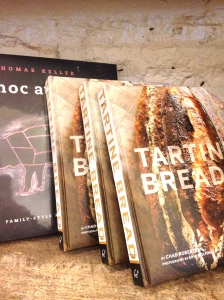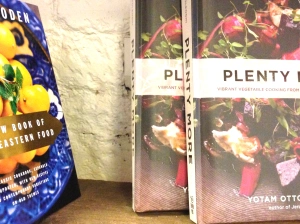Cookbooks for the Ages (Not quite)
December 17, 2014
I proposed recently to the owners of Politics and Prose that we collaborate in selling a list of my favorite cookbooks. For any who don’t know, Politics and Prose, a half-mile from Bread Furst and 30 years old, is one of the most successful independent bookstores in America. It is a Washington monument left by my sister, its founder.
The new owners are terrific and more entrepreneurial than my sister was, more than I am. They were entirely receptive to my proposal and followed up vigorously. So now, if I don’t want to embarrass myself, I must make my choices – my 25 favorite cookbooks (at this moment).
As everyone knows thousands of cookbooks are published each year and some of them are good. A lot of the most successful these days are the consequence of celebrity – of television and particularly the TV Food Network that, in its popularity, has become almost a parody of itself. Nonetheless people buy cookbooks on which those celebrities put their names (and often proud photos of their hair and their cleavages as well).
I would have imagined the universal availability of recipes on the Internet would have killed cookbooks. Plowing through a stack of books for broccoli recipes seems unnecessary now that typing “broccoli recipes” into a computer will uncover everything from Gourmet, Epicurious, Serious Eats, and all other wisdom of the ages. And why bother even with a written word in the kitchen when an I-Pad can be neatly propped up in the corner of a counter?
But because of our culture’s current interest in food, the cookbook business has been affected less by the general decline in book reading than have other segments of the book business.
So cookbooks still sell. Perhaps people buy them as gifts. Perhaps because our interest in cuisine has broadened to include many unfamiliar cultures people want to familiarize themselves with those cuisines new to them. Perhaps readers like the extravagant photography in many books. Perhaps – I hope – a lot of them are being read and perhaps even cooked with.
I don’t use cookbooks as I did when I was learning to cook. I started cooking at home seriously when Julia Child’s Mastering the Art of French Cooking was the gold standard. Not only did it introduce French cooking to Americans who didn’t know much about French food; but the specificity of its recipes, the ease of following them, made French cooking seem possible to most of us who thought of it as beyond us.
This book more than any other book then important, The Joy of Cooking, The Settlement Cookbook, The Fanny Farmer Boston Cooking School Cookbook, was an instruction manual to an ostensibly unfamiliar cuisine. It seems quaint now to think of it that way.
This exploration into (some of) my favorite cookbooks has made me think a lot about the way in which cookbooks are now used. As I thought about the list of books I would like to have on a shelf at Bread Furst, I kept excluding nearly all of my very favorite food books. Laurie Colwin’s Home Cooking, Elizabeth David’s French Provincial Cooking, Richard Olney’s Simple French Food are not exactly cookbooks. M.F.K. Fisher wrote about food in ways no one does any longer and her writings are available as a collection in The Art of Eating.
These are not cookbooks. They are food books. Sometimes they are autobiography, sometimes literature, sometimes essay. Some of them have lots of recipes and some have few.
They are not books whose major purpose is instructional. They are meant to explore and inspire and they deserve to be considered apart from cookbooks. Perhaps we should devote a second shelf to them.
I exclude here other books that are really interesting and important – food science like that which is done by the estimable Harold McGee author of On Food and Cooking and The Curious Cook.
I also steered away from technique cooks like Michael Ruhlman’s Ratio and Charcuterie.
Indulging my own conservative orientation, I didn’t include the Nathan Myhrvold magnum opus, Modernist Cuisine, or the books of Heston Blumenthal and the world of the influential (now closed) Spanish restaurant El Builli that probably ought to interest me but don’t.
Without any reservation whatever I excluded all of the diet and aversion books that teach how to avoid gluten, calories, salt, and fat – and I steered around the single food cookbooks like one that includes bacon in every recipe.
And then I found myself abandoning a lot of cookbooks that have been really important in my life and in the lives of millions of cooks – James Beard’s American Cooking, a book given to me by my Aunt when I returned to in Washington from Boston, Deborah Madison’s Vegetarian Cooking for Everyone that showed me the versatility of vegetables, and The Silver Palate, the book that molded the cooking of people who came of age in the 1980s.
These were brilliant influences in their time; Madison still is. But I wanted to point you to books that might help you go beyond the large cookbooks like Mark Bittman’s How to Cook Everything, even though such general cookbooks are awfully useful,
So what on earth is left?
I decided to write about the cookbooks that I think are helping cooks broaden their scope, the ones that permit people interested in food to cook in their own homes cuisines that were inaccessible or even unknown.
This, I confess, is a very arbitrary choice for me to have made but fortunately, Bread Furst has a lot of shelf space and if Politics and Prose indulges us, we’ll make room for other little libraries later.
Now, however, I am going to include in our modest pre-Christmas library the books that over the past three decades have introduced me to a greater range of world cuisine to have in my home than I ever imagined before would be possible to have in my home.
First Mediterranean cookbooks:
There are two queens of the Mediterranean. One is Joyce Goldstein who opened Square One Café in 1984, America’s first avowedly Mediterranean restaurant. She has written 26 cookbooks all of them still in publication. My favorites are Back to Square One, published in 1992, and Cucina Ebraica.
As for Paula Wolfert, I have always thought of her as more anthropologist than cookbook author although her recipes are wonderful. Her Couscous and Other Good Food from Morocco (now, in a new edition, called The Foods of Morocco) was published in 1973 when virtually no one in America knew about this classic cuisine. Her Slow Mediterranean Cooking and Cooking of Southwest France (She claims to have discovered Jean Louis Palladin) are nearly as wonderful.
The greatest cookbook of Middle Eastern food, I think, is Claudia Roden’s The New Book of Middle Eastern Food the first edition of which appeared in 1972. Few Americans then knew about the richness of food in Greece, Egypt and Turkey but you won’t say that after looking at this book.
I admire a lot the wonderful cookbooks of Aglaia Kremetz who presented her latest (and I think best) book in a visit to Washington just last month, Mediterranean Vegetarian Feasts. And Washington’s own Najmieh Batmanglij wrote a marvelous cookbook of Persian Food, a cuisine still little known in the US, called Food of Life, Ancient and Modern Iranian Cooking.
I don’t want to neglect the work of food giants like Marcella Hazan and Joan Nathan (a neighbor of Bread Furst), both of whom, have written abudently, Hazan about Italy, Marcella’s Italian Kitchen, and Joan about Israel and Jewish food of the diaspora Jewish Cooking in America and Quiches, Kugels and Couscous, the Jewish cooking of France .
But the world of Mediterranean cooking and cookbooks generally has been influenced greatly in the past few years by Yotum Ottolanghi, an Israel who lives in London, writes for the Guardian, and operates food shops in London that are quite wonderful. His cooking is boldly flavored and oriented toward vegetables and very Mediterranean. His cookbooks will be on our shelves especially the newest, Plenty More.
I am certainly biased toward the Mediteranean (after all, bread was invented there 6,000 years ago or so). And Mediterranean food is understood and easily embraced by Americans. But one of the wonderful developments of the past 25 years is how open-minded and eager America has become about other foods. It’s now possible in many places, certainly, around Washington to find ingredients for many of the cuisines of the world.
And so I add to our shelves, other favorite cookbooks of other cuisines:
From Asian cultures:
Indian Cooking by cooking teacher and noted actress, Madhur Jaffrey.
Classic Indian Cooking by Julia Sahni, a chef and brilliant recipe-writer.
Mastering the Art of Chinese Cooking by Eileen Yin-Fei Lo, a really beautiful bookof classic Chinese recipes.
Into the Vietnamese Kitchen by Andrea Nguyen, a large collection of recipes and a lot of information about the fundamentals of this now-familiar cuisine.
Land of Plenty by Fuchsai Dunlop, a brilliant exploration of Sichuan cooking
Cradle of Flavor by James Oseland, great recipes from Indonesia and Malaysia.
From Latin cultures (about which my knowledge is pretty thin):
Authentic Mexican by Rick and Deann Bayless, restaurateurs, chefs, teachers.
Gran Cocina Latina Maricele Presilla, a Cuban-born historian, entrepreneur and chef.
And that leaves cooking in the U.S. and here is where I get lost. There are so many wonderful books of American cooking many of them from very good restaurants. I could choose any number of them. Although I am sure I will rue this, I have limited myself just now to a few:
Ad Hoc at Home, the Thomas Keller book that anyone can cook from.
Sunday Suppers at Lucques, written by the Los Angeles chef, Suzanne Goin.
Frank Stitt’s Southern Table, by Frank Stitt, the Birmingham chef, an exploration of Carolina low country cooking.
Heritage by Sean Brock, chef-owner of Husk, the extra-ordinary Charleston restaurant.
Finally, could I create a bookshelf at Bread Furst without books about breads and sweets? Right now my favorite bread books are:
Tartine Bread by Chad Robertson, my copain in San Francisco.
Flour Water Salt by Ken Forbish, a particularly sensible didactic bread book.
And appropriately at the end of the list I offer these dessert books from an opulent library of wonderful dessert books.
Ready for Dessert by David Lebovitz, now best known for his blog about Paris food.
Classic Home Desserts by Richard Sax, a 2001 book that that influenced me a lot and holds up very well.
Sinfully Easy Delicious Desserts by Alice Medrich, author of several other dessert books equally wonderful.
Baking from My Home to Yours, yet another fantastic interpretion of French desserts by Dori Greenspan whose earlier book, Around My French Table, is one of my favorites.
All these books will be available at Bread Furst thanks to Politics and Prose (where obviously they are also available).


